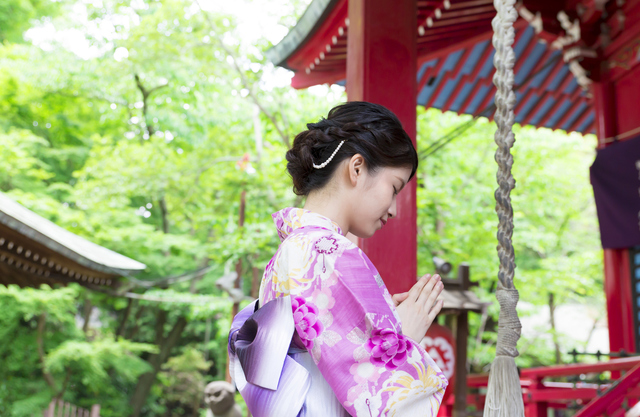Generally speaking, I would explain to foreign tourists that the following should be the way to make a prayer at a Shinto shrine.
Firstly, bow slightly, then, throw money into the offertory box.
A 100-yen coin is very common. Bank of Japan Notes would be more than welcome by Japanese gods. Neither credit cards nor bitcoins would be accepted.
Having said that, I hear that recently some Buddhist temples and Shinto shrines have started accepting donations using smartphones.
Visitors input the amount they are donating into a tablet installed next to the offertory box and pay using a QR code or other methods, which may be more convenient to visitors from overseas.
In the near future, digital donations may become common even at Yakuo-in Temple in Mt. Takao moving with the current of the times.
Secondly, shake a rope to ring the bell, if any, a couple of times.
Ringing the bell is said to summon the spirit of deity and to restore your innocence.
Thirdly, bow deeply twice, and clap your hands twice.
Then, put your hands flat together and make a prayer in silence saying your name and address in the mind.
Nowadays, Know Your Customer (KYC) process should also be important for Japanese gods to identify whose prayers should be answered.
Finally, bow deeply once again, which signifies the end of prayer.
The foregoing is, however, said to be the way that Shinto priests came up with when Shinto was separated from Buddhism in the Meiji Restoration.
They had to differentiate the Shinto manners from the Buddhist ones in a big hurry at that time.
According to one theory, this style of worship has been established modeled on the manners for a Shinto priest to make an offering of branch of a sacred tree with a zigzag shaped white paper called tamagushi before the god.
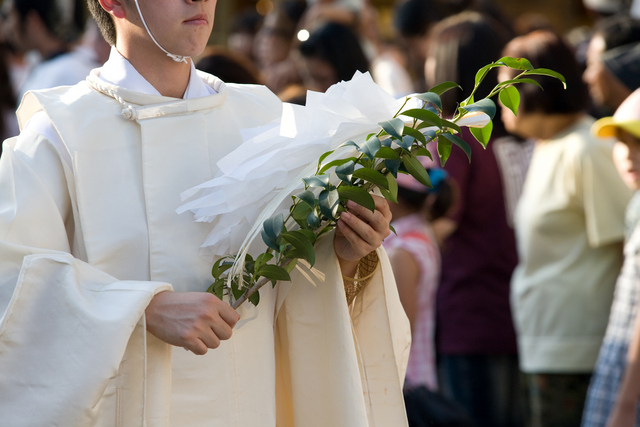
So, it’s a new trend after the Meiji Restoration when the then Japanese government issued the Edict for the Separation of Buddhism and Shinto in 1868 making Shinto the national religion of Japan.
When it comes to the way to make a prayer at Buddhist temples, you are supposed not to clap your hands.
Instead, you just put your hands flat together and make a prayer.
Looks like this Buddhist style worship used to be the common practice at both Buddhist temples and Shinto shrines before the Meiji Restoration.
Have you ever seen a Shinto style wedding ceremony where a couple are supposed to make an offering of tamagushi before the god?

I believe that when my wife and I had a Shinto style wedding ceremony some 36 years ago, we followed that practice by making an offering of tamagushi before the god while my memory is not very clear.
Looks like memories of love tend to be fleeting.
In fact, the history of Shinto style wedding ceremony is relatively short.
It is understood that the very first one was for the royal wedding of the 123rd Emperor Taisho which was held in 1900 modeled on a Christian style wedding ceremony.
Based on the preliminary knowledge mentioned above, how would you make a prayer at Izuna Gongen-do Hall in the precincts of Yakuo-in Temple in Mt. Takao?
You may be confused since in addition to its other Shinto shrine like appearances including a decoration of a Shimenawa you will also see a lot of large sake barrels stacked up as offerings outside the building.
As most of you may be aware, sake refers to a Japanese alcoholic drink made from fermented rice.
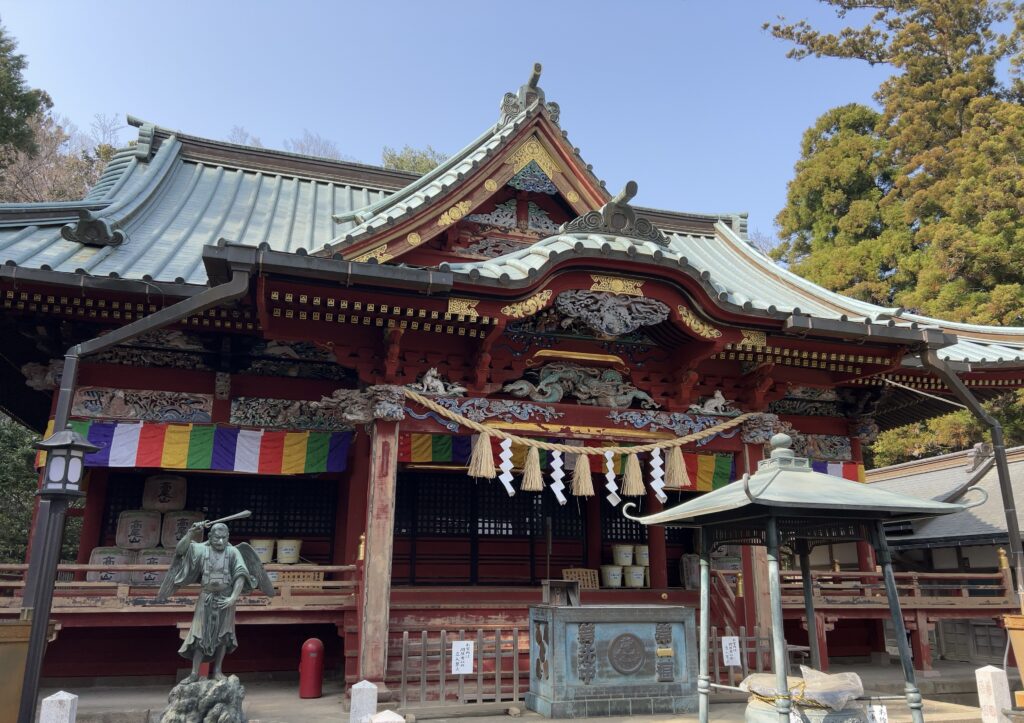
Shinto deities are considered to like sake very much and sake plays an important role in various Shinto rituals and festivals including Shinto style wedding ceremonies.
On the other hand, Buddhist monks are generally supposed to refrain from drinking sake according to the religious precepts while we are aware that sake is traditionally called “hannyato”, literally, “hot water of wisdom” in jargon of Buddhist monks.
Do you know what I mean?
I would suggest, however, that you might follow the Buddhist tradition at Izuna Gongen-do Hall irrespective of its Shinto shrine like appearances just because it is “officially” a Buddhist temple.
When you make a prayer there, reciting Namu Izuna Daogongen, which means Devotion to Izuna Daigongen, will make your prayer more than perfect.
As mentioned above, clapping your hands twice is now very common and a de facto standard as a way of worshipping at a Shinto shrine as of today.
Having said that, this practice is not applicable to Izumo Taisha Shrine in Shimane prefecture where you are supposed to clap your hands four (4) times for some unknown reasons.
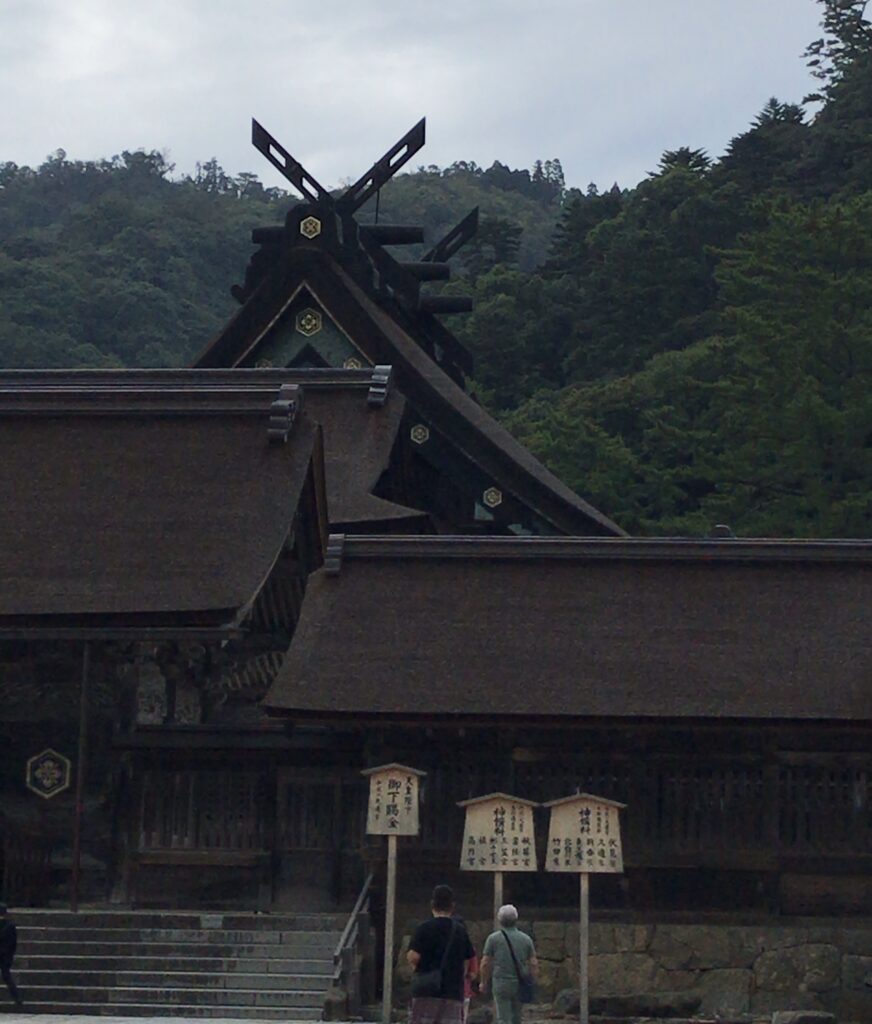
Four is pronounced shi in Japanese.
Shi could mean death.
That’s why no hospital in Japan has No. 4 room.
For a similar reason, there is generally no No. 9 hospital room.
Nine is pronounced ku in Japanese.
Ku could mean sufferings.
One theory is that the practice of four (4) claps is related to the belief in vengeful spirits.
As discussed in the post titled Looks like Zendoki (a good boy goblin) is another henpecked husband, traditionally, in Japan there was a strong belief in vengeful spirits.
Further, it was believed that in order to prevent the vengeful spirits from coming back into this world and/or to avoid the curse of those vengeful spirits it would be effective to enshrine the deified spirits of them, hold the ceremony or otherwise to calm and appease their vengeful spirits.
The Izumo region in Shimane prefecture, which is a theater of Japanese mythology, is home to Izumo Taisha Shrine which has a remarkably long history.
The main hall of Izumo Taisha Shrine is 24 meters high.
It’s the tallest Shinto shrine building in Japan.
Izumo Taisha Shrine is dedicated to Okuninushi, literally, Great Land Owner, the deity who is believed to have created Japan and to have transferred his land to the ancestors of the Japanese imperial family.
It is thought that the main structure of Izumo Taisha Shrine used to be much taller than it is now.
According to an architectural drawing from about 800 years ago, each pillar was made by bundling up three logs, each with a diameter of one meter.
In 2000, the remains of an old structure were discovered.
They revealed that the pillars had indeed consisted of giant logs bundled together and confirmed the accuracy of the drawing.
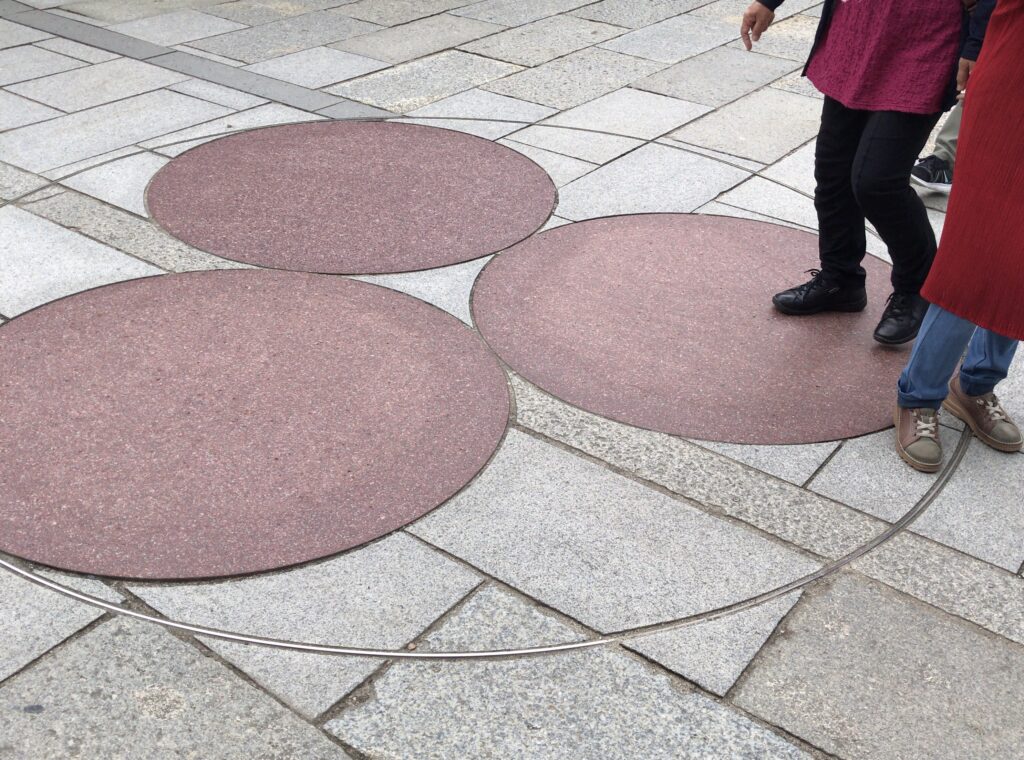
Based on the drawing, experts believe that the structure was 48 meters high and had a ramp 100 meters long.
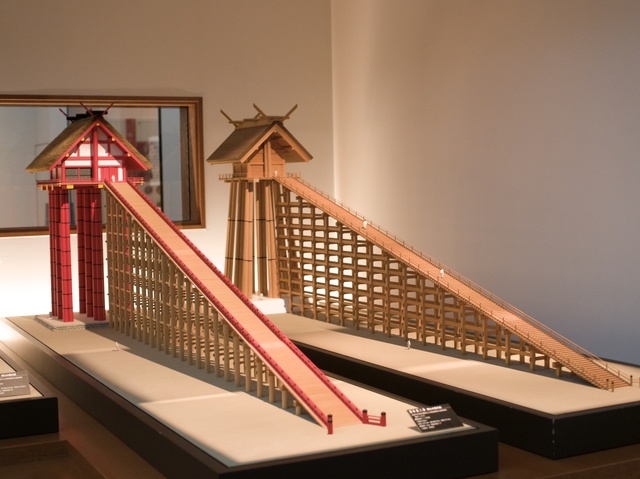
One reasonable hypothesis is that Okuninushi, who had been the ruler of Japan before the ancestors of the Japanese imperial family came to power, was forced to transfer the land to the ancestors of the Japanese imperial family and was killed by them.
Then, in order to avoid the curse of vengeful spirit of Okuninushi, the ancestors of the Japanese imperial family tried to calm and appease the vengeful spirit of Okuninushi by constructing the then largest shrine building in Japan to enshrine the deified spirit of Okuninushi, which is recognized as Izumo Taisha Shrine today.
It was well known even in the ancient times that Izumo Taisha Shrine was the tallest building in Japan.
The accuracy of this information can be verified from the phrases of (i) Unta (meaning Izumo Taisha Shrine as first), (ii) Wani (meaning Todai-ji Temple Daibutsuden (Great Buddha Hall) as second) and (iii) Kyosan (meaning Heian-kyo Daigokuden (Main Hall of Imperial Palace) as third) in Kuchizusami, literally, Reciting, an educational book compiled in 970 by Fujiwara no Tamenori, a court noble in the Heian period.
This educational book includes a lot of poem-like short phrases that are easy to recite so that the children of noble families in those days were able to learn Japanese alphabet, arithmetic (e.g., multiplication table), geography, etc. more easily.
Further, the respective buildings of Izumo Taisha Shrine are decorated with a large Shimenawa twisted from the left from the viewer’s perspective which is against the Principle of Left over Right as if it were to trap the vengeful spirit inside the shrine.
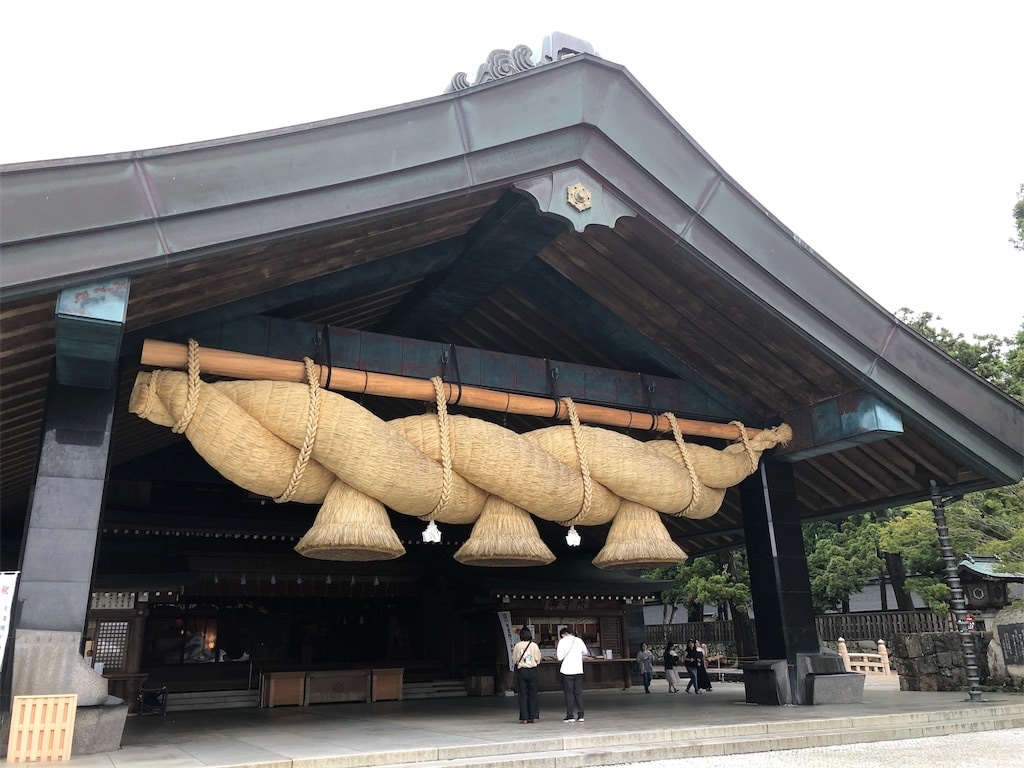
The practice of four (4) claps is to make assurance double (or triple?) sure.
That is, at Izumo Taisha Shrine, the visitors are supposed to pray by clapping their hands four (4) times which means “death” to prevent the vengeful spirit of Okuninushi from coming back into this world and to remind him that he is dead and has become the ruler in the other world.
As discussed in the post titled Looks like Zendoki (a good boy goblin) is another henpecked husband, one theory is that Great Buddha Hall of Todai-ji Temple, the then second tallest building in Japan, was constructed by Emperor Shomu to calm and appease the vengeful spirit of Prince Nagaya who was forced to die unjustly, which appears to be supported by some of the Ah-Un statues (the role of which should normally be to keep out all the evil spirits between the Heaven and the Earth) that are set at the opposite side from the normal positioning as if it were to confine the vengeful spirit of Prince Nagaya in the other world.
We can reasonably assume that the vengeful spirit of Okuninushi who was the outsider of the Japanese imperial family was considered much more powerful than that of Prince Nagaya who was still a part of the Japanese imperial family.
As a matter of course, the foregoing is neither officially nor generally accepted theory.
In fact, Okuninushi is generally considered the god of match-making and popular among Japanese young people.
When I visited Izumo Taisha Shrine in September 2019, I dared to ask one of the local volunteer tour guides about the theory based on the vengeful spirit of Okuninushi mentioned above.
Apparently, he was unhappy about such a theory that connects (i) Izumo Taisha Shrine and Okuninushi both of which he is very proud of as one of the most prestigious shrines and one of the greatest deities enshrined there with (ii) the vengeful spirit of Okuninushi.
He bluntly said to the effect (i) that it should be a bullshit or a foolish talk, (ii) that Izumo Taisha Shrine is so “special” having the longest history that can be traced back to the mythological age and (iii) that consequently the way of worship there could naturally be different from other “ordinary” shrines.
According to one survey conducted by LIFULL HOME’S Research Institute in September 2021, Shimane prefecture was ranked as the lowest (at 36.1 points) based on the tolerance index developed by the research organization among all prefectures of Japan followed by Akita prefecture (at 36.3 points), Toyama prefecture (at 38.8 points), Yamagata prefecture (at 39.8 points) and Aomori prefecture (at 40.2 points) each of which has a lower density of population where they have a tendency to exclude outsiders from local communities and it is so important for them to save face.
I live in Tokyo prefecture which is ranked as the highest (at 77.2 points) based on the same tolerance index and have a very old weekend house in Kanagawa prefecture which is ranked as the 2nd highest (at 73.2 points) in the same survey.
So, I must be tolerant of the impolite remarks made by one of the residents of Shimane prefecture that was ranked as the lowest in the survey.
Incidentally, the ancestor of the chief priest of Izumo Taisha Shrine is said to have been the second son of Amaterasu, the ancestral goddess of the Japanese imperial family.
Further, you may have heard that the current deputy chief priest of Izumo Taisha Shrine (Mr. Kunimaro Senge, the son of the current chief priest) got married to one of the imperial family members (Mrs. Noriko Senge, formerly Princess Noriko of Takamado, the second daughter of Norihito, Prince Takamado and Hisako, Princess Takamado).
As you see from this fact, there has been the close relationship between the two families which can be traced back to the Japanese mythological age.
In a sense, we could say that the successive chief priests of Izumo Taisha Shrine being very much trusted by the Japanese imperial family have been playing “the governor of prison” like role.
As discussed in the post titled Shimenawa symbolizes good harvest, clapping your hands four (4) times is also applicable to Usa Hachiman-gu Shrine and Yahiko Shrine.
According to one theory:
- Izumo Taisha Shrine, Usa Hachiman-gu Shrine and Yahiko Shrine are all located in the regions previously ruled by the powerful local governments all of which had eventually been conquered by the ancestors of the Japanese imperial family.
- All the three (3) regions were culturally advanced areas in those days benefitting from the interaction and trade with the Eurasian Continent thanks to their geographical locations.
- The so-called Three Sacred Treasures that have been the imperial regalia of Japan consisting of the sword called Kusanagi no Tsurugi, the mirror called Yata no Kagami and the jewel called Yasakani no Magatama made of jadeite were all confiscated by the ancestors of the Japanese imperial family from the respective local governments.

In fact, the region where Izumo Taisha Shrine is located has been well known for the production of quality iron sword by Tatara Ironworks (https://tetsunomichi.gr.jp/lang-en/history-development-tatara/) since the ancient times.
A lot of bronze mirrors were excavated in the region where Usa Hachiman-gu Shrine is located.
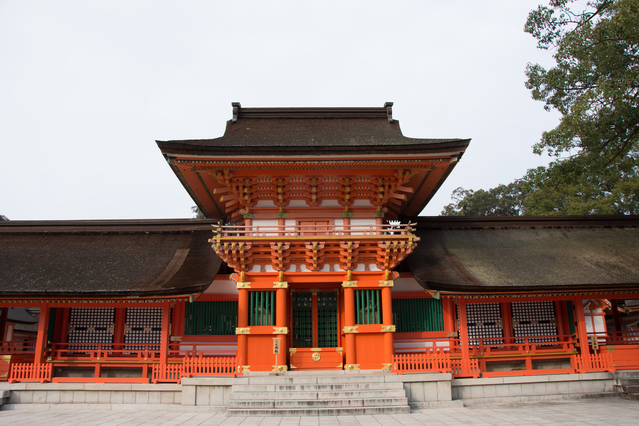
Further, the region where Yahiko Shrine is located is famous for the largest and the best origin of jadeite in Japan.
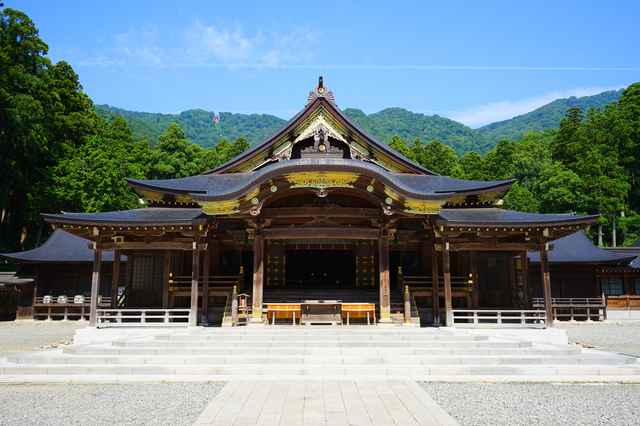
The main production area of jadeite is within the area called Fossa Magna in Latin (the Great Crevasse) (https://geo-itoigawa.com/eng/enjoying/fmm.html), which is named by Dr. E. Nauman, a German geologist who was offered a position by the Meiji government.
In September 2016, jadeite was selected as the national stone of Japan by the Japan Association of Mineralogical Sciences.
Jadeite is also the prefectural stone of Niigata prefecture where Yahiko Shrine is located.
So, the Yamato government then based in the Kinki region (i.e. the area that includes the present-day Osaka, Nara, Kyoto, etc.) established by the ancestors of the Japanese imperial family had to calm and appease the vengeful sprits of local deities in the respective regions by enshrining them and confining them in the other world by clapping the hands four (4) times.
Don’t take it so seriously.
It may be just a bullshit or a foolish talk as the impolite volunteer tour guide at Izumo Taisha Shrine said to me!
